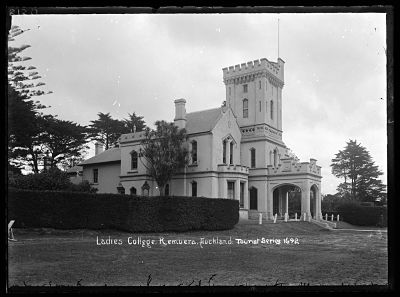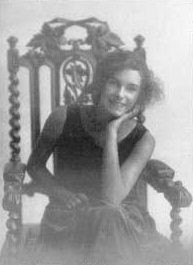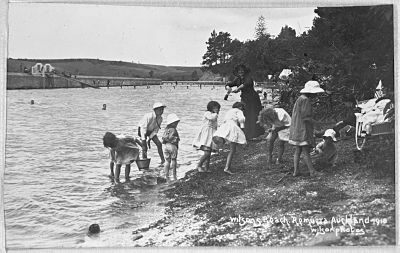A Family in Remuera
by Julie M Hill and Louise Alana Rooney.
The Montgomery Family, Remuera residents in 1917 of 25 Burwood Crescent From the words of Mavis Merlene Hill – Oral History of the Montgomery Family
I live in Remuera and my daughter, Louise Rooney, has lived in Remuera her whole life. While a pupil at Remuera Primary School in 1988, Louise was assigned a history project and for this she choose to do an oral history recording, interviewing her grandmother, Mavis Merlene Hill (nee Montgomery). Mavis grew up in Remuera and Parnell in the early 1900’s. This is the story of her life and of the Montgomery family in her words (with a little editing and additional information about the Ladies College).
Where were you born and when?
I was born in Auckland, in the suburb of Parnell in October 1909. There were four people in my family, myself and my sister, Thelma, and my mother, Eliza, and father Walter.
What did your father do?
My father was the proprietor of a rental car hire garage on the corner of Birdwood Crescent and Parnell Road, which he started in the early days of motor transport.
What school did you go to and what was its history?
I went to the Ladies’ College in Remuera. The Ladies’ College has a very old history. It has now been pulled down. It was a stone building and recently somebody showed me some old English newspapers, from the 1880’s, which had an advertisement saying pupils taken in New Zealand, Auckland, at Ladies College. That was an advertisement for overseas children that may be coming to New Zealand in the 1880’s (the school was started in 1880 by Mrs Catherine Law, as an academy for young ladies, and continued in 1894 under Mrs. Moore-Jones). We also had a lot of island children, sent from the islands, especially the Nelson children, Nelson was very well known, the Nelson girls all went to our school. (Mrs Moore-Jones accepted girls of all denominations, Jewish as well as Christian. Samoan girls were also accepted and made happy).
What was school like then?
School was very strict, it had a big assembly hall where the whole school would meet in in the mornings, and then you would go off to your various classrooms. Mrs. Moore-Jones would walk in a very long black dress, with a little velvet purse hanging off her belt on the side and she would sit in her chair with her daughters one on each side of her, Miss Winnie and Miss Amy. Miss Amy took care of the boarders and the welfare of the school inside, the food and things and Miss Winnie was one of the teachers. At one stage, in the very early stages, they hired some Japanese boys to come into the kitchen and one day, which always remained in my memory, the University was having Capping Day, and the students came out, thinking it would be a great stunt to raid a girls’ school. So they came out in all various costumes and they had a megaphone on the car and hailed the school as they drove down the driveway, which started on Remuera Road and went right down to the end of Garden Road. Everyone got very frightened because they thought the Japanese cook and chef had risen in a riot and we were all petrified. So these varsity students clambered into all the classrooms and hailed you, calling out very familiar things.
Did you know Jean Batten?
Jean Batten was a personal school friend at Ladies College. I went to two parties at her home, in Clonbern Road, just about where the supermarket is now. She was a lovely person, she had dark, curly, short hair and she had a very nice mother. Her father didn’t live at home, he had been a dentist, and there had been a separation and she was very much under the control of her mother.
Can you tell me about the difference between Remuera now and Remuera then?
Remuera now is so busy, the shopping and all the cars, four abreast on each side of the road, tearing past, and in that day, there was just the tramcar. The Victoria Avenue tramcar used to leave every half hour. Some days it would be every hour, and you would trundle for about half and hour in the tramcar, up Victoria Avenue, right down Remuera Road, up Khyber Pass, down Symonds Street to Wellesley Street and if you were going in for business, like I was, it would take you a real half hour in the tram.
Can you tell me about the Great Flu Epidemic?
My father, Walter, had three hire cars at the time of the Great Flu Epidemic in 1918. He had the garage, Montgomery Motors, and he was hired and assigned the Headmistress of the Auckland Girls Grammar School, Miss Gardener, to work with him. They were chosen to go around the Freeman’s Bay and Ponsonby area and they would see what was happening in each house. In some houses both parents were sick or dead and there was a small child or baby in the bed, and they would pick them up and take them down to what is now the sports grandstand in Victoria Park and would put underneath there the bodies for identification and the children were dropped off at various schools to be cared for. The Auckland Girls Grammar School, whose Mistress was with my father, would take a lot of children. During the flu epidemic my sister, Thelma, was a boarder at Ladies College in Remuera. The Moore-Jones family had a relative who was in the Grammar School at the corner of Ayr Street and Parnell Road, and all the boarders from Ladies College, who were well, had to go there and stay as residents and for their classes. The sick girls stayed behind at the school in Garden Road to be nursed. My sister wasn’t allowed to make contact with her parents, maybe because my father was working with the epidemic, and she used to come along Parnell Road and stand on the other side of the street and look over to our garage where my father or myself (only eight years old) would be pumping petrol into cars. She was so homesick to see her family and she wasn’t allowed to cross the road.
Did you enjoy life then?
Well, yes, I loved to play out at night with friends, with no homework and no responsibilities, but later we moved to the bottom of Victoria Avenue to Burwood Crescent, where my parents built their house in 1917. We had the sea underneath, at the bottom of the cliff where we lived and I was able to go down with my sister and swim, that was when I was 10 and onwards. My father made us a kerosene tin which we put a candle in and he made us a spear and we would go and try to find fish (flounder?) when the tide went out, in the mud.
Can you tell me about your horse on Portland Road?
My mother had a horse named Flora that she used to ride from Burwood Crescent, across Victoria Avenue, down around the Shore Road area and down around past little Saint Kentigern’s. She used to amuse a lot of the children around to see my mother on the horse. Thelma, my sister, rode the horse but I wasn’t allowed on the horse because I was too small. The horse stumbled with my sister on the tram tracks going up Victoria Avenue somehow and it went down on both knees, and of course you never take the knees out of a horse. So it was put on the flat bit at the bottom of Shore Road, where there’s nothing but a bit of salt water seeps in down there, and left to roam around for a bit to clear its heels and knees. After a time, when they went down to catch it, it would race off around the paddocks. So we had to get my cousin who went down with the reins and the mouth piece and he chased it around until he eventually got it and got the bridle in its mouth and brought it up, but I’m afraid my mother didn’t have any further confidence in it. So in the old days, the butter man used to come around in his cart with the butter and you used to run out and buy it at the gate like you do the milk now. The butter man came around and said “So you’ve still got the horse?” and we said “well we’ve still got it, but we don’t like it” and he asked if he could buy it and my mother said yes and he said he would like to give it a try out before he finally paid for it. The horse never came back, nor did the money and that was the end of Flora!


